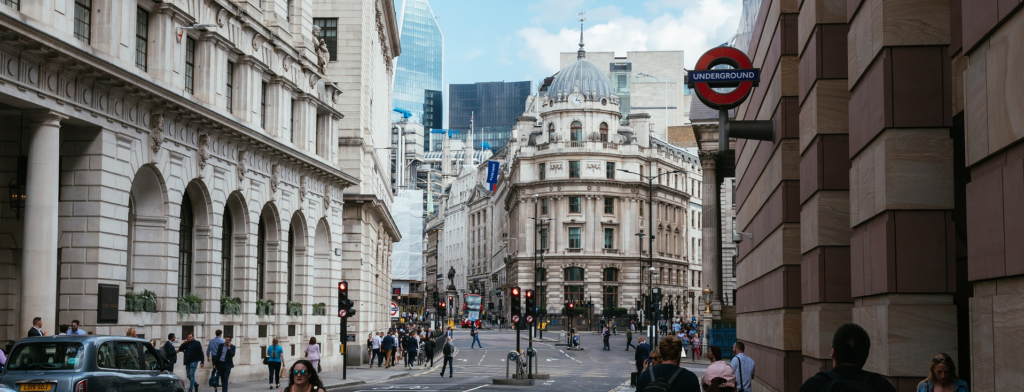A fact-checked and authoritative account of the history of the London Stock Exchange (LSE). The London Stock Exchange is one of the worlds largest and most well-known exchanges for the trading of shares and bonds. Its history intersects with other historical events that took place in Britain or abroad. All investors should know the origins of this famous financial institution.

Origins of the London Stock Exchange
In 1571, Queen Elizabeth I opened the Royal Exchange, Britains first specialist commercial building which facilitated the trade of goods, including alcohol and imported commodities.
In the 17th century, stockbrokers were prohibited from using the building owing to a lack of manners and decorum shown by some of their numbers. The ostracised stockbrokers chose to meet in coffeehouses, which were popular at the time with the middle classes. Coffee was first imported into Britain in 1650 and coffeehouses quickly established themselves to share this new product with Londoners.
At the turn of the 18th century, stock trading occurred in multiple locations across London with varying levels of ‘regulation’. Informal trading continued in coffee establishments such as Jonathan’s Coffee House, as well as the open streets and at the Bank of England.
The first iteration of the London Stock Exchange as an institution was The Stock Exchange as Capel Court. This comprises a large space for stockbrokers to meet and deal in the shares of companies. At the time, companies could only be formed by royal charter (thanks to the Bubble Act 1720). Members paid a subscription to enter the exchange.
Other regional stock exchanges formed independently in booming industrial cities such as Manchester. These would later fold into the LSE in 1973.
Issues with the London Stock Exchange in the early years
The original London Stock Exchange was plagued with fraud and unscrupulous actors.
Prior to 1720, a proliferation of new companies sought to raise funds from investors. Even stockbrokers had poor access to reliable information at the time, which meant that many investors bought shares in worthless companies during periods of mania. One can draw easy parallels between the early Stock Exchange and the cryptocurrency market of today.
Early limits were also placed upon the number of member brokers who could transact in the exchange; which was both a practical measure (space was limited) but also one that enhanced trust between the participants, who would know each other.
The London Stock Exchange was closed for a 5 month period in 1914 following the commencement of what would become the First World War. The closure was designed to provide breathing room for a strained financial system in the context of panic in the financial markets.
The move from open-cry to digital stock trading
The advent of technology and looser regulation paved the way for a revolution in how shares are traded.
In the 1970s, the London Stock Exchange still operated using ‘open cry’ trading pits where stockbrokers sold shares to other stockbrokers in their proximity through verbal auctions. Client orders would be telephoned into brokerages, who would pass their orders to the member brokers who could access the trading floor.
This was an exclusive space that kept the cost of trades relatively high. It was only economic to buy or sell shares in large blocks and investors did not buy and sell securities with the same frequency that they do today on investment apps.
Side note: even today, only a shortlist of stockbrokers are officially members of the London Stock Exchange and are entitled to trade directly on the exchange.
This all changed in the 1980s with the deregulation of financial services, which is referred to as the ‘Big Bang’. This wasn’t one but many rule changes:
- The exchange was opened up to foreign individuals and companies
- Segregation of duties among exchange participants (which generally restricted trade) were removed
- Stockbrokers could trade electronically from remote locations rather than being present on the trading floor
- Fixed minimum commissions were abolished
- Stockbrokers could be acquired by retail banks and no longer needed to be independent.
The cumulative effect of these changes meant that the London Stock Exchange exploded in size and trading volumes. Historic data shows that between 1980 and 1993, the total market value of companies listed on the LSE increased tenfold from £86.7bn to £810bn (source).
The golden era for retail investors
Following the Big Bang, a wave of new UK stockbrokers arrived on the scene with one objective; to provide the lowest cost trading for retail investors.
Initially, trade orders were still placed over the phone but the arrival of the internet led to fully automated systems. Trade commissions fell dramatically, increasing the access of ordinary savers to the stock market. A monthly investment of £200 could now be drip-fed into a variety of shares and funds without a large percentage being given to stockbrokers.
AJ Bell (read review), and Hargreaves Lansdown (read review) are two such brokers companies. Now themselves FTSE 350 companies with billions of assets under management.
The ‘discount broker’ revolution eventually extended to asset managers themselves, such as Vanguard, who slashed management fees on their investment funds. In conjunction with low trading commissions, these changes have improved the expectation returns for investors and made investing a simpler process.
The modern-day London Stock Exchange
London Stock Exchange Group plc (Ticker: LSEG) which is listed on, you guessed it, the London Stock Exchange. Its name gained the ‘Group’ suffix after it acquired Borsa Italiana (the Italian Stock Exchange) in 2007.
The LSE has remained acquisitive. In 2021 it acquired data and trading company Refinitiv for $27bn. Its more recent acquisition of risk management firm Quantile Group is expected to be approved by regulators and completed in 2022.
The exchange has long since abandoned a physical venue for trading. It’s headquartered in Paternoster Square near St Pauls Cathedral in London is reserved for back-office staff rather than stockbrokers.
We hope you’ve enjoyed this brief history of the London Stock Exchange.